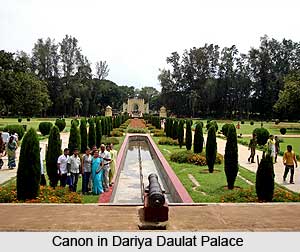 Dariya Daulat Palace is the palace in Mysore, which is known as the "Land of Palaces". Dariya Daulat Palace is one of the palaces that a tourist can visit while visiting the places of Mysore is Srirangapatna. This place is famous for the glorious rule of Tipu Sultan. After the death of Tipu Sultan in the year 1799, the British East India Company shifted the capital back to Mysore and placed the child King Krishnaraja Wodeyar III on the throne of Mysore. From that time, the Wodeyear kings began to rule Mysore and its adjacent areas.
Dariya Daulat Palace is the palace in Mysore, which is known as the "Land of Palaces". Dariya Daulat Palace is one of the palaces that a tourist can visit while visiting the places of Mysore is Srirangapatna. This place is famous for the glorious rule of Tipu Sultan. After the death of Tipu Sultan in the year 1799, the British East India Company shifted the capital back to Mysore and placed the child King Krishnaraja Wodeyar III on the throne of Mysore. From that time, the Wodeyear kings began to rule Mysore and its adjacent areas.
Srirangapatna is an island in the Kaveri River, about 14kms from Mysore. In Srirangapatna, the Palace named Dariya Daulat Palace which is known as the Summer Palace of Tipu Sultan is set amidst beautiful garden. The beautiful garden, now serves as the hot spot for the photo shoot is called Daria Daulat Bagh. Tipu Sultan, who was known as the "Tiger of Mysore" built Dariya Daulat Palace or the Summer Palace in the year 1784. Tipu Sultan ruled Mysore from here for a short time after his father Hyder Ali wrested power from the rulers of Wodeyar Dynasty in the middle of the 18th century.
Dariya Daulat Palace is built in the Indo-Sarcenic architectural style. Dariya Daulat Palace is mostly made up of teakwood. Dariya Daulat Palace has a rectangular plan and is built on a raised platform. There are open corridors along the four sides of the platform with wooden pillars at the edges of the Plinth. The western and eastern part of Dariya Daulat Palace have walls the other two wings have recessed bays with pillars supporting the roof. The four staircases are inconspicuous, built in the four partition walls that divide the audience hall into four rooms at four corners with a central hall connecting the eastern and western corridors.
The most stunning feature of the Dariya Daulat Palace is that all the space available on the walls, pillars, canopies and arches have colourful frescoes. The outer walls of Dariya Daulat Palace have frescoes of the battle scenes and portraits. The inner walls of Dariya Daulat Palace are decorated with scrolls of thin foliage and floral patterns. The wooden ceilings are pasted with canvas painted with floral patterns. With all, Dariya Daulat Palace is the perfect royal palace, which is attracted by the large number of tourists in India and abroad.
Interior of the western wall of Dariya Daulat Palace lies the mural paintings with Rajput style. The paintings depict the celebrated victory achieved by Haider Ali and Tipu Sultan over the English lead by Col. Bailee in the battle of Pollilur near Kanchipuram that occurred in the year 1780. The regal panels on the left wing depict the armies led by Hyder Ali and Tipu Sultan going to battle and on the right wing Col. Bailee is shown seated in a palanquin troubled, with the English army surrounding him, besieged by the army of Tipu Sultan.
There is a painting at the extreme top right of the interior of Dariya Daulat Palace portrayed the French soldiers led by Lally, who are looking through a telescope. The painting in Dariya Daulat Palace shows the cultural, economic and the political condition during the time of Tipu Sultan, who seized the princely state of Mysore from the Wodeyear Kings. The paintings also show the political friendship of Tipu Sultan and the French East India Company. The top panels show the Nizam of Hyderabad and his army of horsemen and elephants arriving a little too late to help his allies, the British East India Company. The eastern wall has paintings in five rows representing the scenes of Darbars of different contemporaries of Tipu Sultan including the Hindu Rani of Chittor, the Raja of Tanjore, the Raja of Benares (Varanasi), Balaji Rao II Peshwa, Magadi Kepegowda and Madakari Nayaka of Chitradurga and Krishnaraja Wodeyar II.
On the top floor of the Daria Daulat Palace is the Tipu Sultan Museum. The museum has a collection of Tipu memorabilia, the European oil paintings and Persian manuscripts. The museum of Tipu Sultan has the famous painting "Storming of Srirangapattanam" an oil painting by Sir Robert Ker Porter made in 1800. This historical painting depicts the final fall of Srirangapatana on 4th May 1799 and the death of Tipu Sultan while he was saving the Capital. Tipu`s men are seen giving stiff resistance to the British army and many British officers are clearly visible in the painting. In background behind the fort walls are seen parts of the Dariya Daulat Palace and the minarets of the mosque. Close by is Tipu`s fort that lies in ruins now. It is in this fort that Tippu died fighting the British. In the fort are the Jama Masjid and the Ranganathaswamy Temple. The Palace of Tipu Sultan is the Lal Mahal lies in ruins nearby. Outside the fort is the Gol Gumbaz that contains Tipu`s tomb, his father Haider Ali`s tomb and his mother`s tomb.




